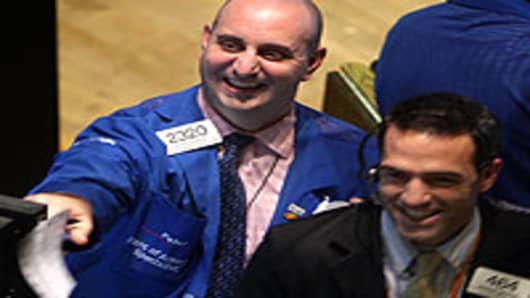Recent economic weakness and subsequent gyrations across the financial markets have otherwise uneasy investors convinced of at least one thing: The Fed isn't going anywhere.
The second leg of the central bank's official easing policy—known as quantitative easing, or in this case, QE2—comes to a close at the end of June with the conclusion of $600 billion in Treasury purchases.
But the goal to maintain economic stability will remain. So whether it's called QE3, QE Lite or some other nickname, market pros believe Chairman Ben Bernanke will make sure the Federal Reserve remains ensconced in the market until the economy gets much better.
"Bernanke has said time and time again the Fed will be there to support the economy," says Gary Flam, portfolio manager at Bel Air Investment Advisors in Los Angeles. "They might not call it QE3. It might come under a different form or different disguise. But the government will continue to support the economy as long as they need to."
Fed officials have been debating an exit strategy from the nearly $3 trillion in easing, with the most popular plan to raise rates rather than reduce the balance sheetand thus cut off some of the liquidity from QE.
For the markets, the period following the end of QE 2 is still likely to be uneasy. That's already been reflected by seesaw movements in stocks and commoditiesand continued strength in bonds, even though Fed critics believe easing policies ultimately will result in severe inflation, usually an enemy of fixed income investments.
"Since QE2 is not your normal everyday occurrence, there are some people concerned about it," Flam says. "Investors on the whole do not have a lot of conviction. What's going to be the result? Do Treasury yields go up and down? Lots of smart investors are arguing both sides of the coin."
As the 2011 rally has cooled off, the dollar's already heavy influence on market movement has become even more pronounced. Stocks and commodities have moved in unison and bond prices have held steady while yields remain unusually low.
Analysts at Bank of America Merrill Lynch believe the trend for lower rates will continue through the summer—despite the end of QE2—and are advising investors to brace for a shift in leadership in the stock market.
The firm has cut industrials and health care to marketweight and upped pharmaceuticals and biotech to marketweight from underweight. In bonds, BofAML is recommending shorting two- and five-year breakevens on Treasury Inflation Protected Securities. Breakevens are the difference between nominal and TIPS yields.
"We do not view this as a defensive posture," the firm said in a note to clients. "Instead, we take this stance in expectation of further broad market gains, but with a shift in leadership from commodity-led stocks (energy, materials and parts of industrials like machinery) to secular growth stocks."
The prevailing mood, then, is that the end of QE2 may spark some discomfort among investors for the summer, but that will give way to more gains later in the year.
"The market right now is going to be weak—just a meandering market probably for the next month," says Gary Hager, president of Integrated Wealth Management in Edison, NJ. "The March lows are going to hold, I don't think we'll challenge them. There's a very high likelihood that by the end of the year we'll be above 13,000 in the Dow."
But worries also linger about the effect that budget austerity from Washington will have on the markets. With historically high debts and deficits acting as an overhang, there's a pitched political battle happening over where and how much to cut spending and whether to raise taxes.
Efforts to tackle the problem, though, have largely gone nowhere. Austerity efforts, such as those put forth by Rep. Paul Ryan (R-Wisc.) and the so-called bipartisan Gang of Six (now the Gang of Five as one of its Republicans has left the fold), have made little headway.
Ultimately, there seems to be little political appetite, from President Obama on down, for adopting austerity, particularly with unemployment still high and the housing market languishing.
"Obama's got high ratings. He just killed a big, bad wolf, but that's going to fade. So what's next?" Hager asks. "The only thing that could derail the election is going to be a double-dip. By hook or by crook, no matter what it takes, you're not going to see true fiscal austerity until the president is firmly entrenched in his second term."
That means there will be little incentive for the Fed to start tightening and risk an economic slowdown, regardless of inflationary pressures on the horizon.
"The longer the economic data remain weak and the longer the unemployment numbers stay high, there seems to be a growing chorus of analysts who think that the Fed will be forced to use their balance sheet to keep buying," says Quincy Krosby, chief strategist at Prudential Financial in Newark, NJ. "The point is, accommodative policy will stay in place until the data turn around."




